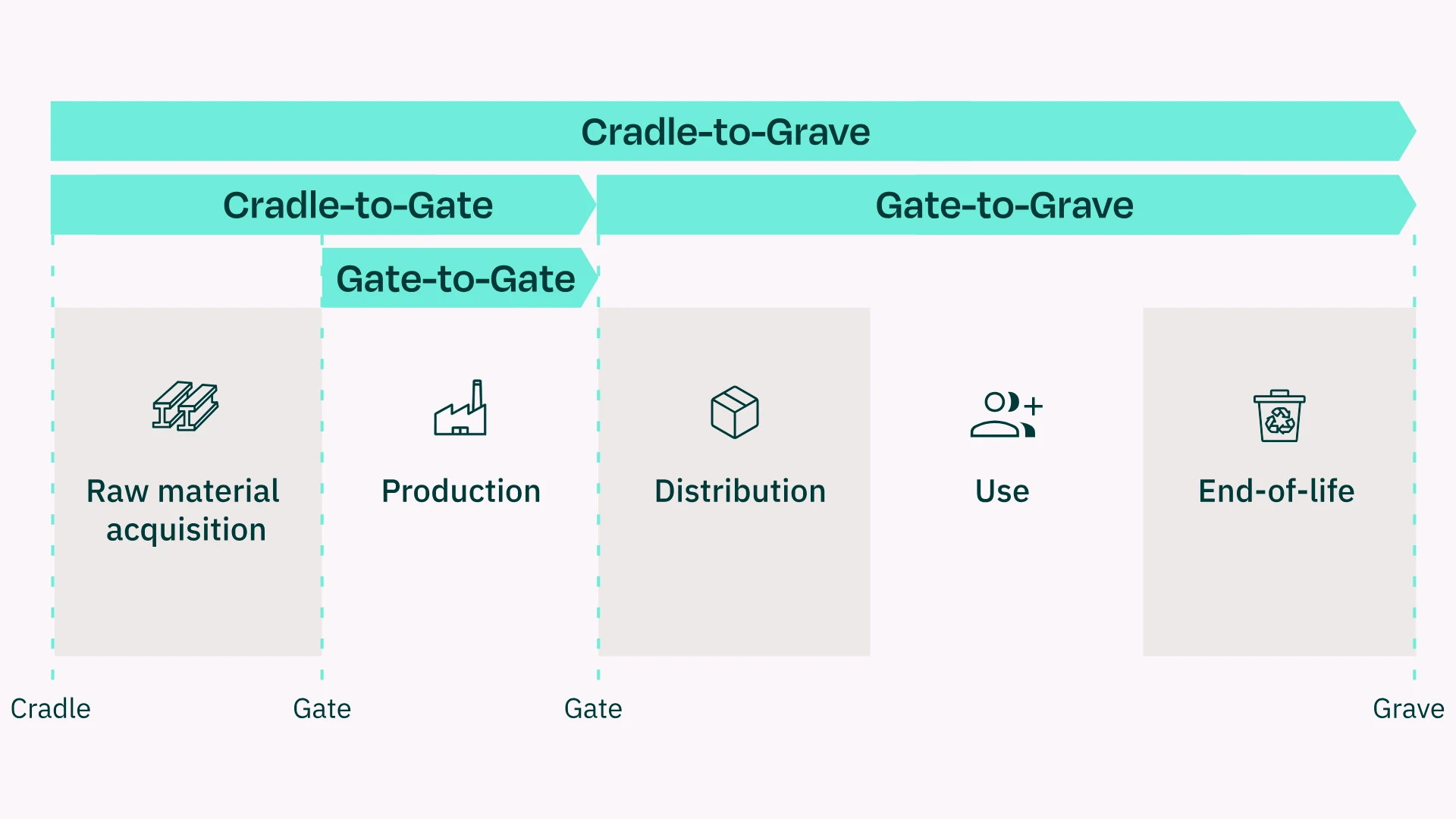
Understanding and Calculating the Product Carbon Footprint (PCF)
If you take decarbonization, product responsibility and long-term viability seriously, the Product Carbon Footprint (PCF) is essential. This article explains what the PCF is, why it matters, how to calculate it – and why a product’s carbon footprint is the key starting point for effective climate management in your supply chain.
Key Takeaways
- The Product Carbon Footprint (PCF) captures the total greenhouse gas emissions of a product across its entire life cycle – from raw material extraction to disposal.
- The PCF is becoming increasingly important for companies, driven by regulations like the CSRD, CBAM, Green Claims Directive, ESPR and sector-specific rules such as the EU Battery Regulation.
- A reliable PCF enables:
- Comparison and management of products based on climate impact
- Identification of emission hotspots in the supply chain
- Informed decision-making in procurement, product development, strategy and communication
What is the Product Carbon Footprint (PCF)?
The Product Carbon Footprint refers to the greenhouse gas emissions (measured in CO₂ equivalents) generated by a product throughout its entire life cycle.
It is also known as the product’s CO₂ balance or product-related carbon footprint. Several standards define the methodological requirements for calculating the PCF:
| Independent Standards | Industry-specific rules | Product-specific rules |
|---|---|---|
| ISO 14067 | TfS PCF Guideline | Environmental Product Declarations (EPD) mit Product Environmental Footprint Category (PEFCR) |
| ISO 14040/44 | Catena-X PCF Rulebook | |
| GHG Protocol Product Standard | PACT Pathfinder Framework | |
| etc. |
Various industries have developed their own sector-specific guidelines for calculating the PCF, some of which are internationally recognized. These include the PACT Pathfinder Framework, the TfS PCF Guideline or the Catena-X PCF Rulebook.
If you calculate your PCF according to ISO 14067, the scope of the assessment depends on the chosen system boundary:
- Cradle-to-Gate: From raw material extraction to the factory gate.
- Gate-to-Gate: Covers only your own manufacturing process.
- Cradle-to-Grave: Extends through use and end-of-life disposal.
- Gate-to-Grave: From distribution to disposal.
- Cradle-to-Cradle: In circular models – includes recycling.
Why Is the PCF Important for My Company?
Regulatory requirements
The PCF plays a key role in ensuring compliance and meeting reporting obligations. Climate-related product data is required in many European regulatory contexts, including:
- CSRD
- CBAM
- Green Claims Directive
- Empowering Consumers for the Green Transition Directive (EmpCo Directive)
- Environmental Product Declarations (EPDs) and the Construction Products Regulation (CPR)
- Digital Product Passport / Ecodesign for Sustainable Products Regulation (ESPR)
- Battery Regulation
- Coming soon: EU Strategy for Sustainable and Circular Textiles
Market Expectations and Long-Term Business Value
Even beyond regulatory requirements, the PCF is a valuable tool for any company pursuing a climate strategy.
- Climate change is putting global supply chains at risk. To respond with more sustainable business practices and reduce emissions, companies first need to understand their own impact and identify hotspots. Low-emission products carry fewer risks.
- In general, ESG data is becoming increasingly important in financing and procurement decisions.
- Customers also expect honest and credible information about product sustainability.
- The PCF brings climate action out of the abstract and into daily operations. With reliable PCF data, you can benchmark your value chain, compare products on the market, prioritize investments and base decisions on measurable impact.
The PCF as a Steering Tool
If your company is just starting out with climate management, it may be unclear where to focus first. You may already have ambitious climate goals—but still lack the data to confidently say how and whether those goals can be achieved.
This is exactly where the PCF comes in:
- It provides reliable and transparent data
- It pinpoints where emissions occur across a product’s production and use
- It enables data-driven decisions in procurement and product development
- It lays a solid foundation for your decarbonization strategy
The PCF as a Strategic Lever
A PCF is more than just a single emissions figure. It creates transparency at the product level—and becomes a strategic lever across multiple areas of the business:
- Product development: The PCF helps identify emission-intensive components and evaluate alternatives. This allows you to systematically reduce the carbon footprint of individual products.
- Procurement: Knowing where your emissions hotspots are enables you to take targeted action and make your supply chain more climate-friendly.
- Sales and marketing: A traceable PCF can strengthen a product’s sustainability profile – provided the communication is honest and well-founded. It gives you a solid basis for credible green claims.
- Strategy and planning: The PCF highlights where emission reduction potential lies within components and the value chain. It also shows which products are environmentally viable and how to systematically decarbonize your portfolio.
PCF, CCF and LCA: Differences and How They Relate
When working on your company’s or products’ carbon footprint, you’ll often come across the abbreviations PCF, CCF and LCA. These three concepts are closely connected but differ in focus and scope:
| Corporate Carbon Footprint (CCF) | Product Carbon Footprint (PCF) | Life Cycle Assessment (LCA) | |
|---|---|---|---|
| Definition | Total greenhouse gas emissions of a company | Greenhouse gas emissions of a product across its entire life cycle | Comprehensive environmental footprint of a product across its entire life cycle |
| System boundary | All company activities (operations, vehicle fleet, supply chain, etc.) | The complete product life cycle (raw materials, production, use, disposal) | The complete product life cycle including upstream and downstream processes |
| Objective | Overview of company emissions, management of climate targets and reduction measures | Determining the climate impact of a product, basis for ecodesign and supply chain requirements | Analysis and evaluation of all environmental impacts of a product (not just CO₂) |
| Relevance | Basis for climate strategy, carbon footprint, CSRD reporting, climate targets | Relevant for customer requirements, product development, ecodesign, supplier assessments | Basis for EPDs, life cycle assessments, ecodesign standards and environmental labeling |
| Data sources | Energy data, business trips, vehicle fleet, procurement, production, suppliers, distribution | Material and process data, supplier data, usage scenarios, end-of-life treatment | Extended product and process data, including water, energy, raw material and land use |
| Scopes | Scope 1, 2 and 3 according to GHG Protocol | Scopes not applicable; based on the product life cycle | Scopes not applicable; based on the product life cycle |
| Addressees | Executive management, investors, banks, regulatory authorities, general public | Customers, procurement, product development, suppliers, end consumers | Sustainability managers, LCA specialists, environmental officers, building and product certification bodies |
In short: The PCF focuses solely on the climate impact of a product within this broader framework. If you’re calculating emissions at the product level, you’ll often use the same methods, data and system boundaries as for an LCA – but the PCF narrows the analysis to greenhouse gas emissions only.
How to Calculate Your PCF in 7 Steps
A reliable PCF lays the foundation for strategic decision-making, targeted decarbonization, compliance with CBAM and other regulations, and credible sustainability communication.
Our practical guide shows you how to get started – step by step, with a clear structure
Download our free guide now:
*This information is summarized editorial content and should not be considered legal advice. VERSO assumes no liability.
